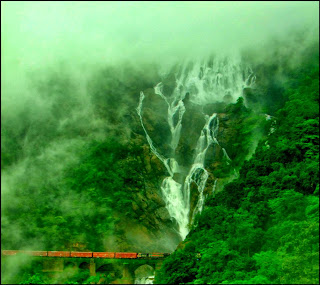The railway track disappears in the
darkness of the menacing tunnel carved into the heart of the sordid mountain.
Tiny streams garland the rugged opening threading their way through green
grass, moss and lichen. The vibrant colours of the day are swallowed by the
seemingly endless void of black in the tunnel as the eyes strain to ascertain
the next step. Water trickles from the indifferent black ceiling as a trekker
ambles on the cold steel of the railway track barely visible in the light of a
torch. The blast of a horn drowns the sound of water gushing in the drains
alongside the track. The deafening roar echoes as the rails rattle signaling an
impatient train rushing to be embraced by the tunnel. The trekker swiftly
clears the track and braces against the slippery walls as the darkness wrestles
with the light of the howling engine. Spitting smoke and fire and screaming the
engine roars past the pinned trekker hauling the rusty compartments of a goods
train. The clattering of the rails become insufferable as the train slithers
through the tunnel searching for the light; and then as the train’s rear fades
in the distance the darkness returns complimented with a deathly silence. The
trekker wipes the grime off his face and resumes his walk, fighting the grasp
of the darkness, towards the light.
Castle Rock is a tiny hamlet nestled in the
Western Ghats on the border of Karnataka and Goa. In the monsoon it is battered
by incessant rains and is wrapped in a cocoon of green fog. Abandoned buildings
covered in moss and lichen dot the landscape around the railway station, a
reminder of the days when Castle Rock served as the frontier between Portuguese
Goa and British India and was milling with travelers going through custom and
document checks. And it is from here a beautiful trek commences to one of the
highest waterfalls in India, the Dudhsagar Falls. Clinging to the railway track
it snakes through mountains laden with dense forests which flirt with the
fickle wind courting the hurrying streams eager to reach the wide expanse of
the plains. Along the way the track plays sheepishly with the contours of the
land – sometimes it curves behind playful hills, sometimes it teases perilous
drops, sometimes it hides in the shadow of the tunnels and sometimes it runs
unabated for miles. Like a cherub it rejoices in the freedom offered by nature,
running wild with excitement and joy.
Rain is a constant companion during the
monsoon months – sometimes it falls gently caressing the trekker with a
motherly love and sometimes it pours furiously punishing the outsider who
treads in her realm. Fog dances on the green mountain tops and in the belly of
greener valleys, wandering at will and enveloping everything in its path.
Streams along the railway track swell with foamy white water and create a
ruckus drowning the sound of the birds chattering in the jungle. The railway
track leaps over scary drops and skirts steep rocky ledges enticing the trekker
for an adventure. En route the sleepy railway station of Caranzol cowers in the
unforgiving rain; railway workers in gum boots inspect the railway tracks
unmindful of the rain. Every once in a while the horn of a train reverberates
in the hills and then the track comes alive shuddering with anticipation. The drenched compartments of the train race
over the icy rails beholding the magical views around them each vying for a
chance to soak in this bliss. The Dudhsagar Falls, a kilometer beyond the
Dudhsagar railway station, aptly mark the climax to this tryst with nature – the
delicious dessert complimenting a fulfilling meal.
The
conflict in nature is most evident in the graciousness of a waterfall. To
behold water strive against rock for years and years and ultimately leave an
impression on the seemingly stoic mountain is a humbling experience. This is a
contest between two stalwarts of nature – the resilient river and the
impregnable mountain. During the monsoon months the force exuded by these falls
can be felt by merely attempting to cross the old railway bridge across the
river – one is literally blown off his feet. To appreciate their elegance,
however, one must trek another kilometer along the track to a view point from
where the river can be seen descending down the face of the mountain like a
spilt tumbler of pure milk. The sight of a train passing with the waterfalls in
the backdrop is a treat for the observer, the train appearing to be a child’s toy
in the presence of the majestic falls.
Tents dot the camping space close to the
falls with huddled trekkers who desperately crave to feel this camaraderie with
nature. As the day turns into night the roar of the waterfall grows fearsome
occasionally punctuated with the penetrating wail of the horn of a goods train.
The rhythmic sound of the wheels hugging the iron in conjunction with the
pitter patter of the rain is a lullaby for tired souls. For this one night the
trekker can aspire to be the courageous water rushing to the edge of the
mountain and taking a leap to the depths below – unfazed by its fate and destiny
riding the wings of unadulterated freedom!
Text and Photos by Deeptangan Pant







